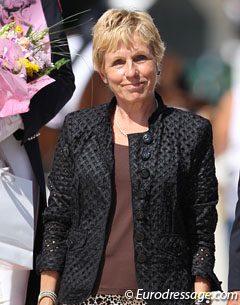
Wayne Channon, IDRC secretary-general and regular Eurodressage columnist, attended the FEI Freestyle Judging Test Event held in Warendorf, Germany, on 24 - 25 September 2013. While the musical and artistic aspect remained untouched, major progress has been made in defining the Degree of Difficulty aspect for the freestyle. Read Channon's impressions from the Test Event:
Kur Judging Comes to the 21st Century - Enter Katrina the Great!
I was impressed; actually, astounded would be a more accurate term. At the FEI Freestyle Test Event, Katrina Wüst presented a new system for judging the Degree of Difficulty in the Freestyle that was almost the finished article. When it is completed, it has something for everyone: riders will get a way of being able to take the guess work out of knowing what mark the will get for this element combined, it will be transparent and much more accurate. Judges will have a way of awarding scores that automatically result in a DoD score that is fair and accurate, one that they can defend objectively and unemotionally. And spectators will be able to see how riders' creativity is rewarded, they will know what is coming and be able to join in the judging experience and tension of knowing what impact this will have on the final result.
Katrina's system is simple: for each movement and for each combination of movements there is a published table (the "Catalog") of levels of difficulty. For example, currently we have no consensus of whether a piaffe pirouette is artistic or difficult and if it is difficult, just how difficult. Combinations will be similarly categorised. For example, a double pirouette into extended canter into a double pirouette into 1 tempi into 2 tempi on a curved line will be a 5 combi with an additional degree of difficulty of tempi on a curved line - this is heading for a very serious Dod. Riders will be able to consult the Catalog and work out that if they are able to do this (and each movement will have to be scored at a 6.5 or above to count) then they will get a definite mark for this.
 This means that a rider can go with a young horse and know that they are only submitting a plan that will result in a DoD score of 70% and an experienced GP horse with talent may submit a DoD sheet for a 9.5. If they pull it off, then they get the mark. If the rider doesn't pull it off, they will know exactly why they didn't get the mark. All riders will be in the same boat, no extra marks for being famous, no extra marks because you are going last.
This means that a rider can go with a young horse and know that they are only submitting a plan that will result in a DoD score of 70% and an experienced GP horse with talent may submit a DoD sheet for a 9.5. If they pull it off, then they get the mark. If the rider doesn't pull it off, they will know exactly why they didn't get the mark. All riders will be in the same boat, no extra marks for being famous, no extra marks because you are going last.
To balance the upside, it does depend on the judges giving the correct mark for each movement and that is not assured with the system of judging the technical element.
The next step is non-trivial: the riders, trainers and judges have to agree on the Catalog. The IDRC will be debating this at our General Assembly on the 28 October at the Global Dressage Forum. If you are an international rider, then you need to be there, your future marks depend on it!
Other trials
Other small changes to the system of judging the freestyle were considered with the main two:
- Awarding decimal marks for each of the Artistic elements - this was considered to be good as it allowed a 7.7, say, to be given rather than a 7.5. The theory was that if we give decimals then it will be more accurate. I think it is admiral to aim for decimal scoring but I see no way that a 7.7 can be given with any accuracy. If judges are unable to accurately give half-marks then are not able to give decimal marks without changing the whole approach to this. So, in my view, this is a false positive. It will result in judges keeping in mind what they have given to the other competitors and awarding 0.1 more to a test that is better or -0.1 to a similar test that was not so good.
- Two judges sitting together, one of them giving the Technical mark and the other the Artistic mark - in theory, this should be an improvement as it divides the judging task. In practice, two judges sitting together could be seen as one influencing the other and probably would not give the right image publicly. Separating the judging tasks is definitely worth considering even though this was tried (and failed) at Aachen in 2009. At that trial, the Artistic judges ended up giving too high a mark compare with the technical mark. This is a complex area and needs to be further examined to see if this could work with some refinement - I certainly would not write this off as a failure.
Every great journey...
The highlight of the two days was the Degree of Difficulty proposal. It only counts for 10% of the total Freestyle test, so this is not a panacea, nor was it intended to be. It is the first step in producing a Code of Points where each of Artistic elements can be objectively measured. The others may be more difficult to formularise but they can be done. Clearly, the next step is to examine how the accuracy of the Music and Choreograph can be improved and I am very much looking forward to this.
I can only congratulate Stephen Clarke as the new Dressage Judge General, Katrina Wüst and the rest of the team on an intelligent, thoughtful approach that bodes well. As Lao-tzu said, a journey of a thousand miles starts with one step, we have made ours.
-- by Wayne Channon
Photos © Astrid Appels
Related Links
FEI to Review Dressage Freestyle Judging at Upcoming Test Event in Warendorf
Wayne Channon: Judging Has to Move into the 21st Century
Cees Slings: Is it Time for Freestyle 'Goal Line Technology'?